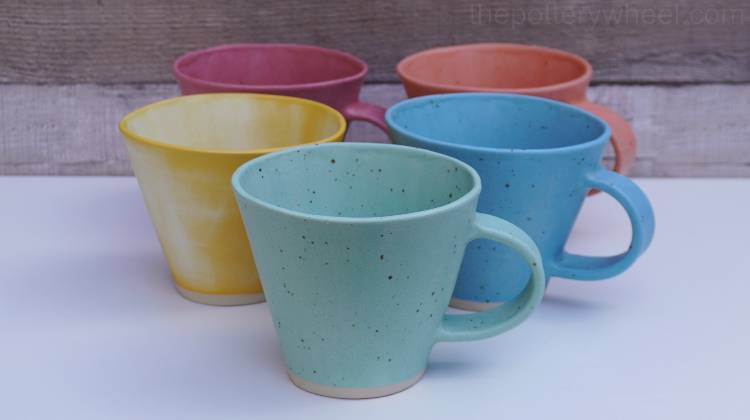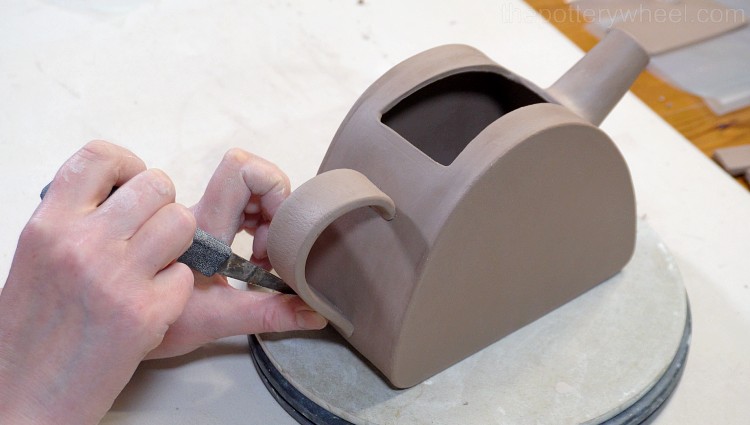If you’re starting out in ceramics, you may be wondering about the different types of clay for pottery. This information can feel overwhelming, so I thought it would be helpful to give a clear overview of the key differences. In this article, I will take a walk through the main different types of clay for pottery. I will look at what they are made of, what they look like, and what they are like to use.
There are five main types of clay for pottery. These are earthenware, stoneware, porcelain, ball clay, and fire clay. Earthenware fires at lower temperatures and can have an earthy look. Stoneware fires at mid to high temperatures and is often buff or tan. Porcelain fires at high temperatures and is usually pale grey or white.
In this post, I will be giving you an overview of each of these main types of clay for pottery. I will also take a look at ball clay and fire clay. If you would like to jump to a particular section, use one of the links below to take you directly there.
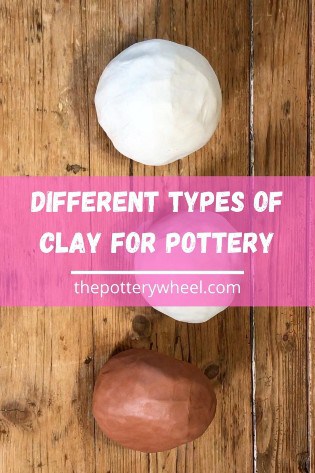
Firing Different Types of Clay for Pottery
Pottery clay is also known as ceramic clay. This is because part of the process of making pottery involves firing it in a kiln. Firing clay involves heating the clay to high temperatures.
During the firing process pottery clay is transformed from clay that can dissolve in water, into hard insoluble ceramic material. This is one of the differences between pottery and ceramics.
One of the main differences between various types of clay for pottery is the temperature at which they become ceramic. Different types of clay can cope with different levels of heat.
Some clays can withstand very high temperatures, these are called mid or high fire clays. Other clays can only cope with lower firing temperatures, and these are called low fire clays.
Once clay has become ceramic in the kiln, it is said to have ‘matured’. Different types of clay for pottery mature at different temperatures. And they mature in different ways too.
Some clays, such as stoneware and porcelain become very hard and non-porous when they mature.
Other clays such as earthenware are porous and less hard, even when they have matured and become ceramic. Being porous does not however mean that earthenware will dissolve.
When earthenware has been fired, it is still ceramic. However, it does still absorb water.
There is a sweet spot when firing different types of clay at which the clay has matured. If the kiln goes beyond that temperature, the clay may start to bloat up. And it will crack and break into pieces. Or if the temperature gets very high, the clay may even melt into a puddle on the kiln shelf.
So, with that said, let’s look at the different types of clay for pottery…
Different Types of Clay for Pottery – Earthenware Clay
When people talk about earthenware clay, they are often actually talking about terracotta clay. Terracotta is the lovely rich red-colored clay that is often used to make plant pots and the like.
However, there are various different types of earthenware clay, of which terracotta is one. Other examples include this low-fire white clay and raku clay.
What is Earthenware Clay?
Earthenware clays are low fire clays. The temperatures at which low fire clay is fired at ranges from between 1479 and 2109F (804-1154C). Another way of putting this is that earthenware clays are normally fired between cone 015 and 1.
When potters refer to the cone a type of clay is fired, they are talking about the pyrometric cone system. This is a way of classifying the ranges of firing temperature. If you’d like to know more about this, have a look at this article.
1479 -2109F are the extreme ends of the low fire spectrum. An average firing temperature for low fire clay is around 1950F or cone 04(1).
What Does Earthenware Clay Look Like?
A lot of earthenware clay is red or orange. This is because it often has a high content of iron oxide(2), which is essentially rust. However, earthenware clay can also be yellow, white, and tan, or buff.
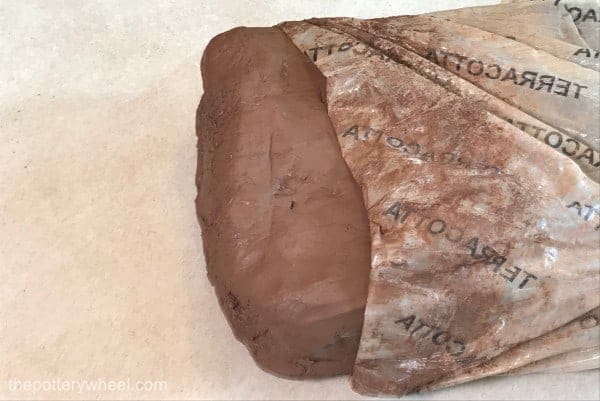
Some earthenware clay can look quite smooth and refined when it’s been fired. However, earthenware clay has a reputation for looking earthier, more coarse, and rustic than other types of clay or pottery.
The reason for this is that once it has been fired, earthenware clay is more porous than other clay bodies. Clay is made up of clay particles or platelets. As clay is fired, these platelets move closer together. Also, glass produced by the clay body during firing fills up the spaces between the clay. The glass also bonds the clay particles together and gives the pottery strength. This process is called vitrification.
Different types of clay vary in how dense they become and how much glass is produced. If a clay produces less glass during firing, then the gaps between the particles are more open. And the resulting piece of ceramic is still somewhat porous.
Earthenware clay produces less glass during firing than other types of clay for pottery. For that reason, it’s less vitreous than other kinds of clay. In fact, the term ‘vitrified’ is used to refer to stoneware and porcelain clay that has been fired to maturity.
What can Earthenware Clay be Used for?
Because earthenware clay is more porous than other types of clay, it is less dense and less strong. As a result, earthenware will chip and break more readily than stoneware or porcelain.
To make earthenware clay waterproof and therefore suitable for dinnerware, it needs to be glaze fired.
Usually, when ceramics are being made, they are fired twice during the production process. The first fire is the bisque fire when the clay is turned into hard ceramic. And the second fire is the glaze or glost fire.
Most types of clay for pottery are bisque fired at around cone 06 or 04. This is between 1830-1940F (999-1060C). When clay is bisqueware it is still relatively porous.
With some clay, like stoneware, during the second firing, the temperature of the kiln is much higher than the first. And it is in the high temperatures of the glaze fire, stoneware and porcelain will undergo vitrification and reach maturity.
However, because earthenware clay lacks the glass-forming ingredients to become fully vitrified. And it cannot withstand the same high temperatures during the glaze firing. If you fire a low fire clay at a mid or high fire temperature it will break or melt.
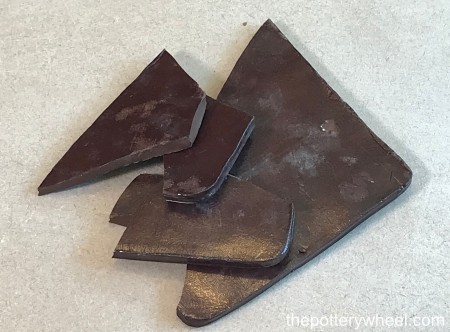
Some pottery, such as raku ware, cannot be made fully waterproof. However, earthenware clay can be made waterproof and functional by glazing it well.
Glazing involves painting, dipping, or spraying raw glaze onto the bisque fired pottery. During the glaze fire, the glaze melts and then hardens forming a glassy layer over the pottery.
Although glazed earthenware can be waterproof, out of the different types of clay for pottery, it is less strong.
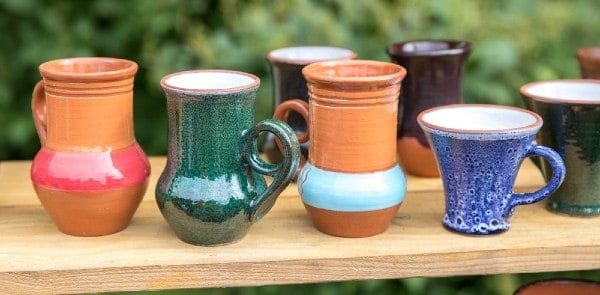
What is Earthenware Clay Made from?
Clay is a product of the earth, and it is collected from the ground and then processed. Some potters will actually source clay themselves and use it raw. But most potters will buy clay that has been commercially processed.
In the environment, over the years, deposits of clay minerals form as rocks are gradually eroded. These clay minerals can gather at the point where they are formed. This is known as primary clay. Or the minerals can be transported to a different location and settle there. This is known as secondary clay.
Because secondary clay has been transported, usually by water, it will pick up sediment and particles on route. As a result, secondary clay is less pure than primary clay. Earthenware clay is a secondary clay.
The type of clay body that is formed depends on the kind of rock that is initially eroded. It also depends on the sediment that it picks up on its journey.
Once a commercially produced clay body has been mined from the ground, it is processed in a plant. This usually involves, amongst other things, crushing, grinding, and screening(3).
Other ingredients can be added to the clay as it is being processed to enhance its performance. For example, ‘frit’ can be added to earthenware to make it denser when it has been fired. Frit is a manufactured glass powder that melts at low temperatures(4). By adding frit to the earthenware, its glass-forming potential is increased. Therefore, making it stronger and less porous.
What is Earthenware Clay Like to Use?
Earthenware clay has a reputation for being quite plastic. A ‘plastic’ clay is quite soft and workable, meaning it’s easy to shape.
Also, plastic clay will keep its form when it has been shaped. Some clay has a tendency to slump or return back to its original shape when it is being used.
Plastic clay tends to be quite cooperative and will keep the shape it has been fashioned into. Because it is plastic, earthenware clay is a good clay for beginners.
I like working with earthenware clay, in particular, terracotta can feel very nice to throw on the wheel. Some clay has a mind of its own and takes a bit of persuasion to do what you want. However, I find terracotta quite cooperative and generally does what I ask quite easily.
If clay has added grog it will feel gritty. However, if it does not contain extra grog, terracotta can feel silky smooth on the wheel.
Different Types of Clay for Pottery – Stoneware Clay
One of the next types of clay for pottery that we are going to have a look at is stoneware. Like the term earthenware, stoneware is an umbrella term that refers to a variety of different clay bodies.
However, in general, stoneware, as its name suggests, is tough when it has been fired. Compared to earthenware clay it is denser, more resistant to breaks and chips, and less porous.
What is Stoneware Clay?
Stoneware clay fires at higher temperatures than earthenware clay. Normally stoneware clays mature when fired in the mid to high fire range.
In practice, this means that they are fired somewhere between 2010-2370F (1100-1300C). Using the language of the cone system, this means stoneware is fired between cone 4 and cone 10.
The temperature that is used to fire stoneware depends on the clay body itself. And the potter’s own preference. Normally manufacturers will state the temperature range that best suits a clay body on the packaging. And potters will choose a temperature that suits them within that range.
The mid-range firing temperatures are usually thought of as cone 4-7. And High firing temperatures are cone 8-10.
Here is a table to help clarify what temperatures are considered low, mid, and high fire. And also, what cones are associated with each temperature range:
| Temperature Range | Temp Fahrenheit | Temp Celcius | Cone |
|---|---|---|---|
| Low Fire Mid Fire High Fire | 1830-1940F 2157-2264F 2305-2381F | 999-1060C 1186-1240C 1263-1305C | 06-04 4-7 8+ |
You will often hear potters talking about a cone 6 stoneware or a cone 10 stoneware. This refers to the temperature they fire at, but also the kind of stoneware they are using.
What does Stoneware Clay Look Like?
Stoneware clay comes in different colors, but it’s often grey when it is moist. The depth of color will vary from a pale grey to quite a deep grey color.
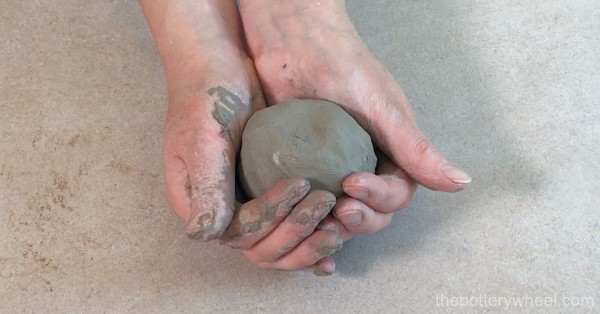
This normally lightens up when it’s fired. So, a stoneware that is a very pale grey when it’s wet will look off-white when it’s fired. And a stoneware that is a darker grey in its wet workable state will be tan or beige when fired. However, you can also get black and brown stoneware.
Because stoneware is tough and quite non-porous, it’s often used by commercial manufacturers to make dinnerware. Stoneware used commercially is often made of quite refined particles. As a result, the fired product has a smooth consistent look.
However, stoneware used by potters for making pottery by hand often has a speckled look. This is partly to do with impurities in the clay. But it is also the result of grog that is added to the clay to improve its performance.
Grog is clay that has been fired, and ground up into granules. This is then added back into a clay body. Grog makes clay easier to work with and less likely to crack when it dries. The grog granules are made in different sizes. Larger granules will give clay a gritty grainy appearance.
What can Stoneware Clay be Used For?
As stated above, clay contains glass-forming materials that melt when the clay is fired. Some clays contain more of these glass formers than others. And stoneware clay produces more glass when it is being fired than earthenware.
Therefore, provided stoneware clay has been fired to a high enough temperature, it will be more vitreous than earthenware. A vitreous substance is basically a glass-containing material. And materials can be more or less vitreous depending on how much glass they contain.
The more vitreous a material is, the less porous it is, and the more waterproof the item becomes. Some fired stoneware clay is vitreous, and other stoneware is semi-vitreous, meaning it is semi-porous.
Either way, stoneware is less porous than earthenware and this makes it more suitable for functional use. Stoneware is a common choice of clay for dinnerware and water holding vessels like vases.
This is partly to do with the fact that it is less porous than earthenware. But it is also to do with its strength. Vitrified pottery is stronger and denser than non-vitrified pottery. So, stoneware is less vulnerable to chips and breakage than earthenware pottery.
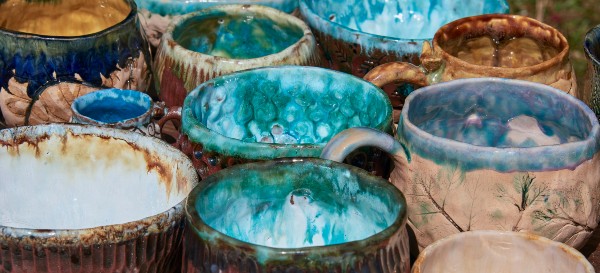
What is Stoneware Clay Made From?
Like earthenware clay, stoneware is a secondary clay. This means that when it’s being formed in the environment, it picks up impurities. It is then mined, processed, and prepared to be used for the production of pottery and ceramics.
Part of the production process involves refining and blending the ingredients of the clay. As already stated, there are lots of different types of stoneware. However, broadly speaking stoneware is a mixture of feldspar, quartz, and ball clay.
Feldspars are used as fluxes in clay and glazes. Fluxes reduce the melting point of glass-forming ingredients in clay. Quartz is a mineral with a high content of silica. And silica is one of the main glass-forming ingredients of clay.
Ball clay is a very plastic type of clay that is often added to stoneware clay to make it more workable. Also, fire clay is sometimes added to stoneware. This raises the temperature that it can be fired to, and is a common ingredient in high fire stoneware.
Some stonewares do contain kaolin, which is the main ingredient in porcelain. These stonewares are sometimes described as being “porcelaneous’.
What is Stoneware Clay Like to Use?
Different types of stoneware vary in how they feel to use. However, stoneware has a reputation for being easy to use. It is generally quite plastic, workable, and versatile.
Some stoneware clay feels quite smooth and silky to use. However, if it has added grog or sand it can feel more coarse and gritty.
I tend to think of stoneware as being like a reliable workhorse. That sounds unflattering, but what I mean by that is that it can be used for a wide range of techniques. It is cooperative, and will usually do what you want it to do. And it is strong and durable.
At the same time, it can look refined and delicate, without being as high maintenance as porcelain.
And on that note, let’s take a look at porcelain clay.
Different Types of Clay for Pottery – Porcelain Clay
One of the more refined types of clay for pottery is porcelain clay. Porcelain clay is sometimes referred to as kaolin clay.
However, kaolin is a very pure kind of white clay also known as china clay. Kaolin is actually used as a primary ingredient in making a wider range of porcelain types of clay. Normally porcelain clay bodies contain other ingredients too.
What is Porcelain Clay?
Porcelain is a high fire type of clay, which means that it usually fires at temperatures from 2232F (1222C) upwards. However, it is most often fired above 2300F (1260C), which is cone 9.
Depending on the particular type of porcelain being used, it will mature between cone 6 and 14. However, it can be mixed with other ingredients that bring its firing temperature down.
What does Porcelain Clay Look Like?
When it is moist, porcelain clay is usually either a very pale grey color or a white/off-white color. Once fired, porcelain is normally white and can have a translucent appearance.
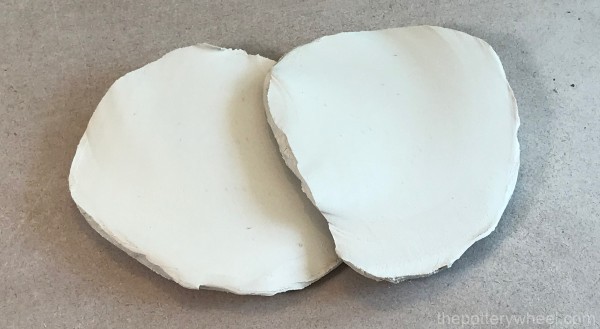
The particles that porcelain is made from are very fine. Because they are so fine, the number of clay particles in porcelain is higher than in stoneware and earthenware. For this reason, porcelain can be pulled and shaped into very thin delicate forms.
What Can Porcelain Clay be Used For?
When it is fired to maturity porcelain clay has very low porosity. Which means that it absorbs little or no water. It is also very dense and hard.
The exact degree of porosity and density depends on the particular porcelain clay body. Nevertheless, broadly speaking porcelain is non-porous, impermeable, and very dense.
Porcelain has the capacity to look very delicate and refined but is also tough and non-porous. So, its uses are many and varied. It can be used for detailed sculptural artistic work.
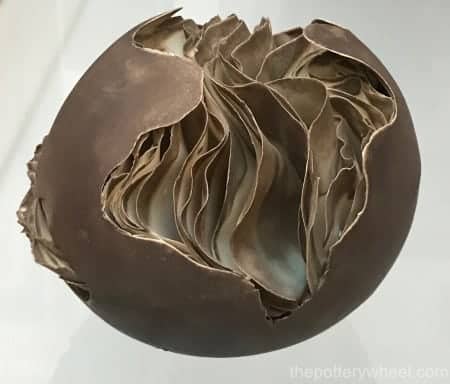
But equally, because of its practical qualities, it is a good choice for functional pieces like dinnerware. Its toughness means it’s resistant to chips and breaks. And, its low porosity is beneficial from a food safety point of view.
In addition to this, because it can be so hard, it has other industrial and medical applications. For example, its toughness is one of the reasons porcelain is used in areas as diverse as dentistry and mechanics.
What is Porcelain Clay Made From?
One of the ingredients of porcelain clay is kaolin clay. Kaolin is a primary clay mineral and as such, it is very pure.
Secondary clays are carried from their point of origin by water and wind and pick up impurities. By contrast, primary clays stay at the geographical point where their rock source is located.
As such, the clay sediment settles and forms where the rock has been eroded. Consequently, the clay body is less contaminated with additional minerals like iron and other debris.
Like earthenware and stoneware, there are different types of porcelain clay bodies. Each different type of clay has different properties to work with. And these properties depend upon the blend of ingredients used to manufacture the clay body.
The other raw materials often used to manufacture porcelain are feldspar and quartz and ball clay.
What is Porcelain Clay Like to Use?
Porcelain feels smooth and refined to the touch, however, it has a reputation for being challenging to use.
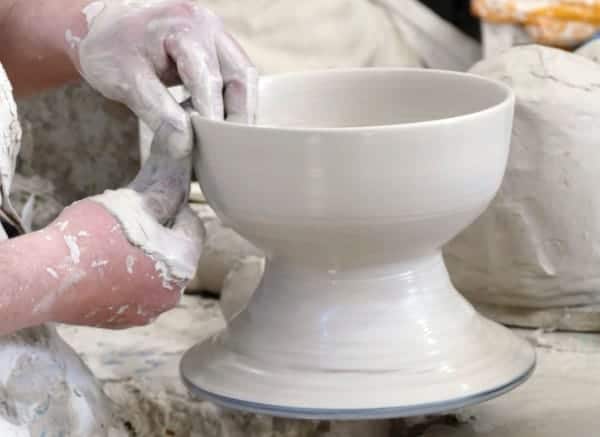
Some potters learn to throw using porcelain and prefer it for its smoothness and delicacy. However, it is not the easiest clay to use for a few reasons. The first is that porcelain is not particularly plastic.
As outlined above, plasticity refers to a clay’s willingness to retain the shape it has been formed into. If you pinch a plastic clay it will keep the shape that it has been given. Less plastic clay has more of a mind of its own and will return to its original shape or slump.
Kaolin clay has low plasticity. And because kaolin is a key ingredient in porcelain clay, a lot of porcelain clays are less plastic too. By contrast, ball clay has high plasticity, and is often added to porcelain to make it more workable and cooperative.
Another feature of porcelain that can make it challenging, especially for beginners, is that it is quite thirsty clay.
What this means is that it dries out quickly and needs additional water to be added as it’s being worked. The more water that is added, the softer it becomes. So, it has a habit of becoming waterlogged, soft, and simply collapsing as beginners try to get it to cooperate.
Different Types of Clay for Pottery – Ball Clay
Earthenware, stoneware, and porcelain are the main types of clay for pottery. However, as you become more familiar with different clay bodies, you will probably hear potters talk about ball clay. Here is an overview of ball clay and how it is used by potters…
What is Ball Clay?
Ball clay is a raw material that is normally sold in powdered form. It is not really used as a clay body in itself. Rather it is added to other types of clay to enhance their performance.
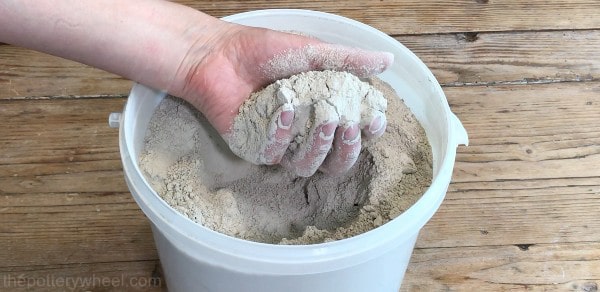
The key feature of ball clay is that it is very plastic. As explained above, plasticity means that clay is very workable. It can be formed easily and will hold its shape once it has been molded.
The reason that ball clay is so plastic, is to do with particle size. A key ingredient in ball clay is the mineral kaolinite. This is an important ingredient in most clay bodies. However, what distinguishes ball clay from other clay bodies is its particle size.
Ball clay is made up of very fine clay particles or clay crystals. Because ball clay particles are so refined, they have a large surface area for water to adhere to. There is also a lot of space between the clay particles for water to reside.
The high water content in ball clay is the reason why it is so plastic. This plasticity makes ball clay a very helpful additive to other clay bodies to make them more workable. For example, ball clay can be added to porcelain clay to make it easier to shape and use.
Because ball clay is made up of fine particles it is also often used to make terra sigillata. This is a very refined clay slip that is used to decorate pottery to a high sheen.
The Challenges of Ball Clay
Ball clay is a very useful addition to different types of clay. However, it also has properties that need mean it needs to be handled with care. These properties are as follows:
Ball Clay Can be Tricky to Dry
Because of its high water content, ball clay shrinks a lot when it dries. This needs to be factored in when making pottery.
The dried and fired piece will be smaller than it was when it was greenware. This is true of all pottery. Clay does shrink when it dries. However, this is particularly true of clay that contains a higher percentage of ball clay.
Shrinkage can be factored in when you are making your pieces. However, the fact that it shrinks a lot, means you need to take care when drying your work. If one part of your pottery dries faster than another, it will put the drying clay under stress.
This stress can cause the pottery to crack as it dries. Ball clay is particularly prone to cracking because the shrinkage rate of drying clay is so high. When one part of your pottery shrinks much more than another, the clay is more likely to crack.
Organic Matter in Ball Clay
Ball clay is a secondary sedimentary clay. As such, when it is extracted from the ground it contains waste material and contaminants. Some of these are organic materials that need to be burned off when the clay is fired.
Unlike kaolin, ball clay has a relatively high organic matter content. Organic matter burns out of clay during firing when the kiln is between 400 and 750F. Pottery with a high ball clay content benefits from being fired carefully through this window.
Ball Clay Coloration
Ball clay fires to a light tan or buff color and it is less white than kaolin. So, whilst it may be added to porcelain to improve plasticity, the porcelain can lose some of its bright whiteness.
Different Types of Clay for Pottery – Fire Clay
The last type of clay for pottery we will be looking at is fire clay. Like ball clay, fire clay is usually sold in a powdered form. The main feature of fire clay is that it has a very high firing temperature. In fact, the melting point of fire clay is around 2912F (1600C)(5). And it matures at around 2696F.
When a substance can withstand high temperatures without deforming, it is referred to as being ‘refractory’. Fire clay is a refractory clay.
When it is used in pottery clay, fire clay, like ball clay is used as an additive. It is often added to stoneware clay. And its key function is to raise the temperature firing range of the clay body to which it’s being added. Again, like ball clay, fire clay is not used as a clay body on its own.
As well as being added to other clay bodies, fire clay is used in a number of different ways. For example, it is used to make kiln bricks and oven bricks, which obviously need to cope with high temperatures.
It is also used as a paste to fill in gaps between fire bricks. And to mend cracks and damage to existing kiln bricks.
What Is Fire Clay Made From?
One of the reasons that fire clay can withstand higher temperatures, is that it has a high alumina content. Alumina is a refractory oxide, (Aluminum oxide), and is normally present at a percentage of between 25- 35% in fire clay(6).
Fire clay also has a high percentage of silica (around 60-70%). Silica, like alumina, has a refractory nature(7).
What does Fire Clay Look Like?
In its dry form, fire clay is often buff or grey, though like other clays it lightens when it’s fired.
When it is dry, fire clay is sold in a powdered form. However, it will often contain oversized particles, that give it a gritty quality. As such, fire clay can give the clay body it is added to a ‘toothy’ grogged look.
As well as alumina and silica, fire clay contains a significant amount of iron. When added to another clay, like stoneware, the iron impurities in the fire clay give the stoneware a speckled appearance.
Another feature of fire clay is that it improves the plasticity of the clay to which it’s added.
Final Thoughts on Types of Clay for Pottery
Before you go, for an overview of the properties of earthenware, stoneware, and porcelain clay, check out my full video here.
If you are starting out in ceramics, the array of different types of clay for pottery can feel daunting. I hope the information outlined above will give you an understanding of the broad categories of clay available. Once you have grasped the basics, you will get to know the different types of clay within these categories. And you will figure out exactly which type of clay suits your needs and way of working.


